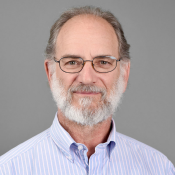2 ASU faculty elected as fellows to National Academy of Inventors
Photo by Deanna Dent/ASU
Arizona State University faculty members Bertram Jacobs and Klaus Lackner have been elected as fellows to the National Academy of Inventors (NAI). Both are being honored for research that addresses a societal need.
The NAI Fellows Program highlights academic inventors who have demonstrated a prolific spirit of innovation in creating or facilitating outstanding inventions that have made an impact on quality of life, economic development and the welfare of society. Election to NAI fellow status is the highest professional distinction accorded solely to academic inventors.
“This year’s class of NAI fellows represents a truly impressive caliber of inventors,” said Paul Sanberg, NAI president. Each fellow is “tackling real-world issues and creating solutions that propel us into the future. Through their work, they are making significant contributions to science, creating lasting societal impact and growing the economy.”
Viral research
Bertram Jacobs, one of the world’s foremost authorities on the vaccinia virus, is a professor of virology in the School of Life Sciences, and a member of the ASU-Banner Neurodegenerative Disease Research Center at the Biodesign Institute.
Vaccinia is a member of the poxvirus family of viruses, closely related to smallpox. Jacobs has genetically engineered vaccinia as a vehicle against various infectious agents, bioterrorism threats and cancer, demonstrating that viruses are not only pathogens to be feared but also can be used to help humanity.
Jacobs has focused on what remains a central challenge for medicine, the development of an affordable and effective vaccine against human immunodeficiency virus, or HIV. His lab has explored poxvirus-host interactions and the strategies these viruses use to evade the body’s innate immune interferon defenses. Disabling immune evasion genes in vaccinia has produced highly attenuated strains of the virus for potential use as vectors against diseases including AIDS, which is caused by HIV.
“The creative process of invention is most fulfilling when it can serve human needs, especially in combating the infectious diseases that continue to ravage humankind,” Jacobs said. “I’m deeply honored to be recognized by the NAI for these ongoing efforts.”
Carbon collector
Klaus Lackner is a pioneer in the field of direct air capture, or DAC, which has successfully removed carbon from air. DAC systems, if deployed on a large enough scale, can help combat the accumulation of CO2 in the atmosphere and help mitigate global warming.
Lackner has been exploring these systems and the materials used in them since the 1990s, when he first wrote a scientific paper outlining that such systems are feasible and may provide a way to combat climate change. One such device based on DAC with Lackner’s involvement is the MechanicalTree, located at ASU and being commercialized by Carbon Collect Ltd.
“The atmospheric carbon situation has become critical, and we need to start doing something about it,” said Lackner, founding director of the Center for Negative Carbon Emissions and a professor in the School of Sustainable Engineering and the Built Environment. “Our device can recycle it, bringing it out of the atmosphere and either bury it or use it as an industrial gas.
“Being recognized by the NAI is flattering,” Lackner added. “It gives me pause, because I am simply trying to find a way to help all of us out of what is a thorny situation on climate. Necessity certainly is a driver of invention, and this is a good example of that.”
The 2024 NAI fellows hail from 135 research universities, governmental and nonprofit research institutions worldwide, and their work spans a wide variety of disciplines. They are prolific researchers holding various honors and distinctions such as the Nobel Prize, U.S. National Medal of Technology and Innovation, the National Medal of Science, and membership to the National Academies of Sciences, Engineering and Medicine.
View the full list of 2024 fellows.
More Science and technology

Turning up the light: Plants, semiconductors and fuel production
What can plants and semiconductors teach us about fuel production?ASU's Gary Moore hopes to find out.With the aim of learning how to create viable alternatives to fossil-based fuels, Moore — an…

ASU technical innovation enables more reliable and less expensive electricity
Growing demand for electricity is pushing the energy sector to innovate faster and deploy more resources to keep the lights on and costs low. Clean energy is being pursued with greater fervor,…

What do a spacecraft, a skeleton and an asteroid have in common? This ASU professor
NASA’s Lucy spacecraft will probe an asteroid as it flys by it on Sunday — one with a connection to the mission name.The asteroid is named Donaldjohanson, after Donald Johanson, who founded Arizona…


